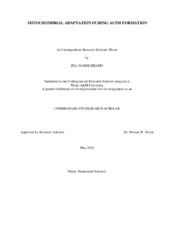| dc.description.abstract | The role mitochondria play in mammary gland development is not fully understood and therefore provides an interesting opportunity to study novel interactions. The purpose of this project is to elucidate unknown cellular mechanisms in normal mammary epithelial cell differentiation. To gain a better understanding of the processes involved in mammary epithelial cell differentiation, we differentiated EpH4 mouse mammary epithelial cells in a three-dimensional, acini model. Utilizing a three-dimensional model more accurately recapitulates the structure of ducts in the mammary gland. Initially, we sought to further understand the role of Sim2s in mammary gland ductal development by manipulating Sim2s expression in EpH4 cells. We were able to confirm the role Sim2s plays in mammary ductal development. We then employed the use of pMitoTimer to trace mitochondrial networks and turnover during acini formation. By creating a new cell line with a tetracycline-inducible construct of MitoTimer, we established a new way to observe mitochondrial turnover over a longer period. We discovered that mitochondria turned over during the course of the acini formation. To understand the role of mitochondrial fusion, we silenced the expression of the key mediator of inner mitochondrial membrane fusion, Opa1, during acini formation. We found that Opa1 expression was necessary for acini formation. To understand the role of autophagy in acini formation, we pharmacologically inhibited autophagosome degradation with Bafilomycin A1. We have previously found that loss of autophagic flux inhibited differentiation-dependent gene expression in two-dimensional differentiation of mammary epithelial cells. In conclusion, we have shown that mitochondria do in fact adapt in a three-dimensional model of mammary epithelial cell differentiation, and this adaptation is required to reach a fully functional differentiation state. | en |


